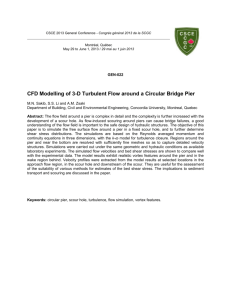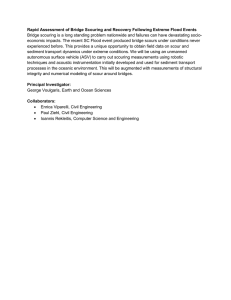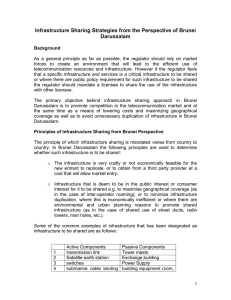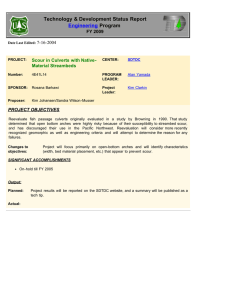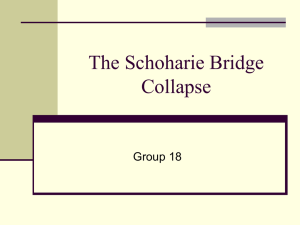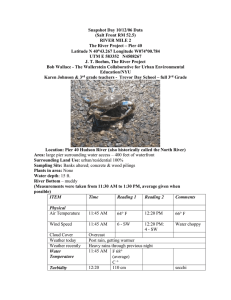Brunei Darussalam Journal of Technology and Commerce
advertisement
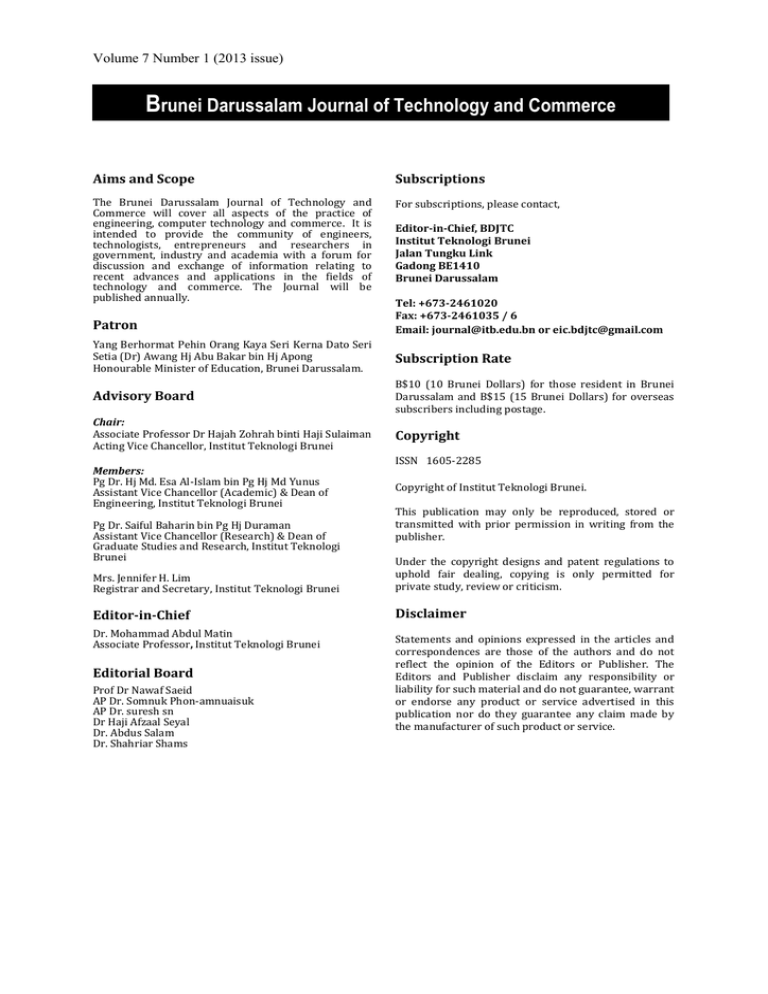
Volume 7 Number 1 (2013 issue) Brunei Darussalam Journal of Technology and Commerce Aims and Scope Subscriptions The Brunei Darussalam Journal of Technology and Commerce will cover all aspects of the practice of engineering, computer technology and commerce. It is intended to provide the community of engineers, technologists, entrepreneurs and researchers in government, industry and academia with a forum for discussion and exchange of information relating to recent advances and applications in the fields of technology and commerce. The Journal will be published annually. For subscriptions, please contact, Patron Editor-in-Chief, BDJTC Institut Teknologi Brunei Jalan Tungku Link Gadong BE1410 Brunei Darussalam Tel: +673-2461020 Fax: +673-2461035 / 6 Email: journal@itb.edu.bn or eic.bdjtc@gmail.com Yang Berhormat Pehin Orang Kaya Seri Kerna Dato Seri Setia (Dr) Awang Hj Abu Bakar bin Hj Apong Honourable Minister of Education, Brunei Darussalam. Subscription Rate Advisory Board B$10 (10 Brunei Dollars) for those resident in Brunei Darussalam and B$15 (15 Brunei Dollars) for overseas subscribers including postage. Chair: Associate Professor Dr Hajah Zohrah binti Haji Sulaiman Acting Vice Chancellor, Institut Teknologi Brunei Copyright Members: Pg Dr. Hj Md. Esa Al-Islam bin Pg Hj Md Yunus Assistant Vice Chancellor (Academic) & Dean of Engineering, Institut Teknologi Brunei Pg Dr. Saiful Baharin bin Pg Hj Duraman Assistant Vice Chancellor (Research) & Dean of Graduate Studies and Research, Institut Teknologi Brunei ISSN 1605-2285 Copyright of Institut Teknologi Brunei. This publication may only be reproduced, stored or transmitted with prior permission in writing from the publisher. Mrs. Jennifer H. Lim Registrar and Secretary, Institut Teknologi Brunei Under the copyright designs and patent regulations to uphold fair dealing, copying is only permitted for private study, review or criticism. Editor-in-Chief Disclaimer Dr. Mohammad Abdul Matin Associate Professor, Institut Teknologi Brunei Editorial Board Prof Dr Nawaf Saeid AP Dr. Somnuk Phon-amnuaisuk AP Dr. suresh sn Dr Haji Afzaal Seyal Dr. Abdus Salam Dr. Shahriar Shams Statements and opinions expressed in the articles and correspondences are those of the authors and do not reflect the opinion of the Editors or Publisher. The Editors and Publisher disclaim any responsibility or liability for such material and do not guarantee, warrant or endorse any product or service advertised in this publication nor do they guarantee any claim made by the manufacturer of such product or service. Volume 7 Number 1 (2013 issue) Brunei Darussalam Journal of Technology and Commerce Contents i Welcome Message Papers Stereo Vision System with Image Segmentation Technique for Robot Arm Applications Swee Kheng Eng, Anwar Hasni Abu Hassan, Tow Leong Tiang and Wee Chuen Lee 1 Homogeneous and Heterogeneous Traffic in Optical Burst Switched Network Suriani Mohd Sam, Hamdan Sayuti and Norsheila fisal 18 An Analysis of Scouring Effects on Various Shaped Bridge Piers Md. Mosabbir Pasha, Aziz Hasan Mahmoo and Shahriar Shams 29 A study on the effect of licensing system upon driver’s attitude in Bangladesh Rabbani Rash-ha Wahi,Shakil Mohammad Rifaat, Nafiz Ul Ahsan and Farzana Leema 43 -------------------------------------------------------------------------------------------------------------------------------- Stereo Vision System with Image Segmentation Technique for Robot Arm Applications Swee Kheng ENG1, Anwar Hasni Abu HASSAN1*, Tow Leong TIANG1 and Wee Chuen LEE1 1School of Electrical and Electronic Engineering, Engineering Campus, Universiti Sains Malaysia, 14300 Nibong Tebal, Penang, Malaysia, e-mail: anwar@eng.usm.my. *Corresponding author ABSTRACT Three-dimensional (3D) information about the environment is essential for robot movement and object inspection in robot arm applications. The stereo vision system is one of the best methods for retrieving depth information. In this research, a pair of cameras is used as a stereo vision module to find the location of an object. The stereo vision system, which consists of camera calibration, image rectification, image segmentation, centroid computation, and object localization, is implemented. Image segmentation is performed through a process of edge-based segmentation, mathematical morphology, and largest area selection. The x,y coordinates are given by the centroid coordinate of the object in the left image, and the z coordinates are computed based on the obtained disparity value. The grayscale left and right images are 100% successful aligned horizontally through the image rectification process. The disparity error is minimized after the image segmentation process. The average error for x and y coordinates are 0.17 cm and 0.36 cm. For the z coordinate, the initial average error is 0.42 cm, but after compensation technique is performed, the average error is reduced to 0.17 cm. Based on the proposed inverse kinematic technique, the robot arm is able to pick up an object with 3D location provided by the stereo vision system. Keywords: Camera Calibration, Inverse Kinematic, Image segmentation, Robot Arm, Stereo Vision. Volume 7 Number 1 (2013 issue) Homogeneous and Heterogeneous Traffic in Optical Burst Switched Network Suriani Mohd SAM1*, Hamdan Sayuti2, Norsheila Fisal2 Teknologi Malaysia, UTMSPACE, Electrical Engineering Department, Jalan Semarak, Kuala Lumpur. Malaysia, e-mail: suriani@ic.utm.my 2Universiti Teknologi Malaysia, Electrical Engineering Faculty, 81310 Skudai, Johor Darul Takzim, Malaysia, e-mail: hamdan@utm.my 2Universiti Teknologi Malaysia, Electrical Engineering Faculty, 81310 Skudai, Johor Darul Takzim, Malaysia, e-mail: sheila@fke.utm.my 1Universiti *Corresponding author ABSTRACT The amount of bandwidth available on fiber optic links has increased dramatically with advances in wavelength division multiplexing (WDM) technology. However, existing optical network architectures are unable to fully utilize this bandwidth to support future highly dynamic and bursty traffic. Optical burst switching (OBS) has been proposed as a new paradigm to achieve a practical balance between coarse-grained circuit switching and fine-grained packet switching which should result in better utilization of the available bandwidth. This paper addresses the fundamental characteristic of traffic models used in OBS DiffServ network. DiffServ provides the network the ability to differentiate between different services, while OBS provides the assembly of packets into burst which is optically switched in the core network. Three DiffServ class types that represent multimedia applications, which are real-time constant bit rate, real-time variable bit rate and non-real time traffic are studied in the paper. This paper is divided into two sections: the packet level for homogeneous traffic and burst level for heterogeneous. The main focus of this study is the average queue delay of a packet/burst waiting in the OBS system. The analytical model in support of the simulation results is also presented. The network and traffic models are developed and validated using the JAVA platform simulator. Keywords: Analytical model, average queue delay, DiffServ, homogeneous, heterogeneous, OBS. An Analysis of Scouring Effects on Various Shaped Bridge Piers Md. Mosabbir PASHA1*, Aziz Hasan MAHMOOD1, Shahriar SHAMS2 1Lecturer, Department of Civil Engineering, Islamic University of Technology (IUT), Board Bazar, Gazipur-1704, Bangladesh, e-mail: mosabbir@iut-dhaka.edu 1Lecturer, Islamic University of Technology (IUT), Board Bazar, Gazipur-1704, Bangladesh, e-mail: hasancee@iutdhaka.edu 2Senior Lecturer, Institut Teknologi Brunei (ITB), Jalan Tungku Link, Gadong, BE-1410, Brunei Darussalam, e-mail: shams.shahriar@itb.edu.bn *Corresponding author ABSTRACT A series of bridge failures due to pier scour, as reported during floods, has rekindled interest in our understanding of the scouring process and for developing improved ways of protecting bridges against scour. As such, attention is being given to the scour design of new bridges and to the inspection, maintenance and management of existing bridge structures. The two major countermeasure techniques employed for preventing or minimizing local scour at bridge piers are increased scour resistance and flow alteration. In the former case, the objective is to combat the erosive action of the scour-inducing mechanisms using hard engineering materials or physical barriers such as rock riprap. In the latter case, the objective is to either inhibit the formation of the scour-inducing mechanisms or to cause the scour to be shifted away from the immediate vicinity of the pier. Other than these, there is another measure that could result in relatively less Volume 7 Number 1 (2013 issue) scouring depth around a pier due to difference in pier shapes. All pier shapes do not exhibit the same amount of scouring for the same flow velocity. In this study, the effect of local scour at a bridge pier is presented for different flow parameters. The adoption of a countermeasure is based on the concept that its existence will sufficiently inhibit and/or deflect the local scour mechanisms so as to reduce the local scour immediately adjacent to the pier. The overall objective of the research is to study the temporal development of scour around a bridge pier in an alluvial channel. More specifically, the objectives are to i) to identify pier shape that responses best in order to minimize scouring effect; ii) to find out the relationship of scouring depth with flow velocity, discharge, depth of flow; iii) to find out parameters on which scouring depth depends and develop a relationship with scour depth for changes in the parameters. The selection of the pier width and shape can help in the reduction of the local scour depth in an appreciable manner. A reduction of about 15% in local scour depth can be obtained by using an elliptical shaped pier instead of using a diamond shaped pier and about 10% in local scour depth can be obtained by using an elliptical shaped pier instead of a circular shaped pier. Keywords: local scour, pier shape, scouring, scour depth. A study on the effect of licensing system upon driver’s attitude in Bangladesh Rabbani Rash-ha WAHI1, Shakil Mohammad RIFAAT2*, Nafiz Ul AHSAN3, Farzana LEEMA4 1Department of Civil and Environmental Engineering, Islamic University of Technology (IUT), Gazipur - 1704, Bangladesh, e-mail: rabbanirash.ha@gmail.com 2Assistant Professor, Department of Civil and Environmental Engineering, Islamic University of Technology (IUT), Gazipur -1704, Bangladesh, e-mail:smrifaat@iut-dhaka.edu 3Department of Civil and Environmental Engineering, Islamic University of Technology (IUT), Gazipur - 1704, Bangladesh, e-mail: nafiz085409@yahoo.com 4 Graduate Student, Department of Civil Engineering, University of Tokyo, Japan, e-mail: leema@trip.t.u-tokyo.ac.jp *Corresponding author ABSTRACT Accidents are prevalent in low and middle income countries and majority of the world’s deaths occur in developing countries due to road crashes. Among many factors contributing to crashes, driver errors and errant behaviors have been attributed by some road safety professionals, and a large proportion of the general public, to be one of the biggest contributors. In Bangladesh, this problem is exacerbated by the lack of proper drivers’ training and testing. As discrepancies are often observed in issuing license in Bangladesh, it is important to know whether the licensing procedure have any effect on drivers’ attitude as this characteristic generally plays a major role in the involvement of crashes. For this purpose, a well-conceived questionnaire survey was conducted on the attitude of heavy vehicle drivers. To fulfill the objective of the study, drivers are classified into three groups: (a) took no test; (b) took some tests; (c) took all tests. Analysis of mean responses and One-way Analysis of Variance (ANOVA) are utilized to assess the influence of existing licensing system on drivers’ attitude in Bangladesh. Keywords: Drivers’ attitude, Heavy vehicles, License Driver, One-way Analysis of Variance (ANOVA).
